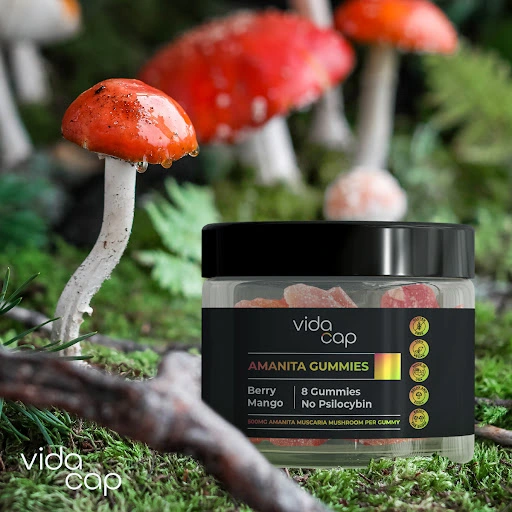Different Types of Amanita Mushrooms

Amanita mushrooms, renowned for their rich diversity, are a captivating group of fungi that possess a wide array of features and effects. Their natural habitats span various ecosystems across the globe, from North America’s dense forests to Europe’s open grasslands. While some varieties of Amanita mushrooms are noted for their edibility and distinct taste, others are infamous for their lethal toxicity. This article delves into the world of Amanita mushrooms, describing several notable types within this genus.
Different Species of Amanita Mushrooms
Amanita muscaria
Possibly the most recognized Amanita species is the Amanita muscaria or Fly Agaric. Interestingly, it’s called the Fly Agaric because of its historical use as a flytrap—when mixed with milk, the ibotenic acid becomes irresistible to flies, leading to their demise.
Amanita muscaria’s iconic red cap, studded with white spots, has been featured in many storybooks and folklore. However, this mushroom carries a potent neurotoxin called ibotenic acid. While rarely fatal in humans, consuming Amanita muscaria raw and uncooked can result in a range of unpleasant symptoms, including hallucinations, nausea, and seizures. Therefore it is vitally important to know how to prepare and cook these mushrooms properly so that they are safe for consumption.
It is important to note that Amanita muscaria contains several compounds, including the aforementioned ibotenic acid, which converts into muscimol during the decarboxylation process. It is also essential to be aware that Amanita muscaria can have psychoactive effects and induce hallucinations, altered perceptions, and euphoria when ingested.
Can You Buy Amanita Muscaria Products Online?
Yes, you can buy Amanita muscaria products online, including edibles, such as Amanita gummies. The market-leading brand, VidaCap, is one such company that offers these products online. VidaCap is an American-based mushroom supplement company that specializes in medicinal mushrooms, such as Amanita muscaria.
One of VidaCap’s most popular products is their Amanita muscaria mushroom gummies. They contain 500mg of premium Amanita extra per gummy and are available in a delicious Berry-Mango flavor.
VidaCap sends batches of its products to independent laboratories for testing to verify their purity and ibotenic acid and muscimol concentration. Customers can view the lab reports on each product page before making a purchase.
The most important thing to know regarding the scientific facts of Amanita muscaria gummies is that the ibotenic acid has been converted to muscimol during manufacture. Muscimol has relaxing and, in some cases, euphoric-type effects.
Amanita phalloides
The next most famous species of Amanita mushroom is The Death Cap, or Amanita phalloides. As you can tell from its name, it is one of the most dangerous species within the Amanita genus.
Amanita phalloides is often mistaken for edible varieties due to its unassuming greenish cap. However, this mushroom contains amatoxins, highly toxic compounds that are not destroyed by cooking. Consumption can lead to severe gastrointestinal upset, liver failure, and death if not treated promptly. The Death Cap is responsible for the majority of mushroom poisoning fatalities worldwide.
Amanita caesarea
On a more positive note, not all Amanitas spell trouble. The Amanita caesarea, known as Caesar’s Mushroom, is highly sought after for its gastronomic value. It’s characterized by a vibrant orange-red cap and yellow gills and stem.
This delicious species of Amanita mushroom is popular in Italian cuisine and was a favorite of Roman emperors, hence the name. Still, foragers need to be extremely careful since it resembles several toxic Amanita species.
Amanita virosa
Another highly toxic species is the Amanita virosa, commonly known as the Destroying Angel. While it may be strikingly beautiful, with its all-white appearance, don’t let its innocence fool you. Just like the Death Cap, the Destroying Angel produces amatoxins.
Amanita virosa’s initial symptoms of severe abdominal pain, vomiting, and diarrhea can be mistaken for a simple gastrointestinal infection. However, these often progress to more serious complications, such as liver and renal failure, if left untreated.
Amanita pantherina
Amanita pantherina, or the Panther Cap, shares many characteristics with Amanita muscaria. It has a brown cap, often adorned with white warts, and contains the same active compound, ibotenic acid. Consumption can lead to a similar range of symptoms as Amanita muscaria. Panther Caps are widespread in the Northern Hemisphere, predominantly in coniferous and deciduous woodlands.
Final Thoughts on Different Types of Amanita Mushrooms
The Amanita genus is an eclectic group of mushrooms, with its species ranging from delicacies to fatal varieties. The different types of Amanita mushrooms are a testimony to the remarkable diversity of nature, encapsulating both the beauty and danger that can reside side by side in the natural world.
Foragers and mushroom enthusiasts should always exercise extreme caution when dealing with Amanitas, as misidentification can lead to potentially fatal consequences.
